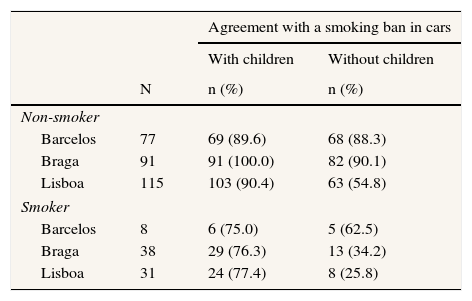About half of the children worldwide are exposed secondhand smoke (SHS) at home.1 Additionally, children are also exposed to SHS inside the vehicles in which they are usually carried, where smoking use results in high levels of SHS concentration.2 The largest study conducted in Portugal about children exposure at SHS in the car revealed that 28.9% of children had been daily or occasionally exposed to tobacco smoke inside cars.3
SHS exposure among children is associated with the development of respiratory infections and chronic symptoms such as cough, impaired lung growth and function, wheezing or dyspnea.1 Beyond the risks for children's health, evidence support the fact that children who live in a microsocial environment where tobacco use is a common behavior have an increased risk of becoming smokers.2 Also, on a different perspective, smoking while driving represents an increased risk of traffic accidents.
Laws banning smoking in cars carrying children have been introduced in a number of jurisdictions in the United States, Australia and Canada, and others, as the United Kingdom, will introduce a similar law in the near future. South Africa and Bahrain have bans on smoking in cars with children, while Mauritius has banned smoking in all cars carrying any passenger.4 Understanding the public opinion about the implementation of new policies is a needful guide for public health decision-makers.
Taking into account the lack of information on this important matter in Portugal, a study aiming to describe the level of agreement with a car smoking ban was developed. It consisted in a cross-sectional study with telephone interviews (based on the protocol of López et al.)5, conducted between May 2013 and October 2014, with a random and representative sample of the population of three Portuguese cities: Barcelos (Bar), Braga (Br) and Lisbon (Lx). The sample consisted of 129 individuals in Br (67 women), 85 in Bar (44 women) and 146 in Lx (74 women), proportional in city size, sex and age group. Overall, 360 individuals, aged between 15-74 years, were asked about their level of agreement on a nation-wide ban on smoking in cars–with and without children. Descriptive analysis was performed.
The majority of the participants supported a smoking ban in cars with children (85% Bar; Br 93%, 88% Lx). Non-smokers were more likely to support this policy (90% Bar, 100% Br, 90% Lx) than smokers (80% Bar, 76% Br, 77% Lx). Table 1 presents the agreement with a smoking ban in cars, with and without children, by city and smoking status of the respondents.
Agreement with a smoking ban in cars, with and without children, by city and smoking status of the respondents.
| Agreement with a smoking ban in cars | |||
|---|---|---|---|
| With children | Without children | ||
| N | n (%) | n (%) | |
| Non-smoker | |||
| Barcelos | 77 | 69 (89.6) | 68 (88.3) |
| Braga | 91 | 91 (100.0) | 82 (90.1) |
| Lisboa | 115 | 103 (90.4) | 63 (54.8) |
| Smoker | |||
| Barcelos | 8 | 6 (75.0) | 5 (62.5) |
| Braga | 38 | 29 (76.3) | 13 (34.2) |
| Lisboa | 31 | 24 (77.4) | 8 (25.8) |
A large public support to ban smoking in cars carrying children was shown. Raising awareness among parents and educators about the health consequences of tobacco use inside the car and encouraging them not to smoke indoors is an urgent need to promote smoke-free cars. Mainly, a ban on smoking inside cars would have immediate impacts on children's health protection. Results from this study strengthens the call for policy-makers to implement strategies to protect this fragile group, starting by banning tobacco use inside vehicles while carrying children.
FundingThis study was supported through FEDER from the Operational Programme Factors of Competitiveness–COMPETE and through national funding from the Foundation for Science and Technology–FCT (Portuguese Ministry of Education and Science) (FCOMP-01-0124-FEDER-009117).
Statement of authorshipThe study was designed by J. Precioso, F. Reis and J. Machado. J. Precioso and L Dias wrote the first draft of the manuscript. I. Sousa and C. Sousa collected the data. J. Precioso and J. Machado designed and carried out statistical analysis. All authors gave a substantial contribution to the interpretation of data, critical discussion and revision of the manuscript, and approved its final version.
Conflicts of InterestNone.
The authors gratefully acknowledge all the participants in the study.
















